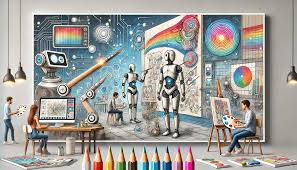
The Role of Artificial Intelligence in Contemporary Art Creation
Artificial Intelligence (AI) has emerged as a groundbreaking force in the world of contemporary art, challenging traditional notions of creativity, authorship, and the very nature of art itself. As AI technologies continue to advance, their integration into the artistic process has opened up new avenues for expression and raised profound questions about the future of art creation.
One of the most notable applications of AI in art is in generative art. AI algorithms, particularly those using machine learning and neural networks, can now create original images, music, and even poetry. These systems are trained on vast datasets of existing art, allowing them to learn patterns and styles which they then use to generate new works. This has led to the creation of AI-generated artworks that can be strikingly beautiful and complex.
The use of AI in art has sparked debates about creativity and authorship. When an AI system creates a piece of art, who is the true creator - the AI, the programmer who created the AI, or the artist who used the AI as a tool? This question becomes even more complex when considering that many AI systems use machine learning algorithms that evolve and improve over time, potentially developing their own "creative" processes.
Collaborations between human artists and AI have become increasingly common. Many artists are embracing AI as a tool to enhance their creative process, using it to generate ideas, explore new styles, or handle complex computational tasks. This symbiotic relationship between human creativity and machine capability is pushing the boundaries of what's possible in art creation.
AI is also being used to analyze and interpret existing artworks. Machine learning algorithms can now identify artists' styles, detect forgeries, and even predict art market trends. This application of AI is transforming art historical research and the art market, providing new insights and tools for scholars, collectors, and curators.
The integration of AI into interactive installations and performances is another exciting development. AI systems can respond to audience inputs or environmental data in real-time, creating dynamic, evolving artworks. This opens up new possibilities for immersive and participatory art experiences.
However, the use of AI in art is not without controversy. Critics argue that AI-generated art lacks the emotional depth and intentionality of human-created art. There are also concerns about the potential for AI to replicate and perpetuate biases present in their training data, raising questions about representation and diversity in AI-generated art.
The legal and ethical implications of AI in art are still being debated. Issues of copyright and ownership become complex when dealing with AI-generated works. There are also ethical considerations about the use of artists' works to train AI systems without their explicit consent.
Despite these challenges, many in the art world see AI as a powerful tool for democratizing art creation. AI-powered tools and platforms are making sophisticated art creation techniques accessible to a wider range of people, potentially fostering a new wave of creative expression.
As we look to the future, it's clear that AI will continue to play an increasingly significant role in art creation. The ongoing development of more sophisticated AI systems, including those capable of understanding context and emotion, promises to further blur the lines between human and machine creativity. This evolving relationship between AI and art is not just changing how art is made, but also challenging our fundamental understanding of creativity and artistic expression in the digital age.